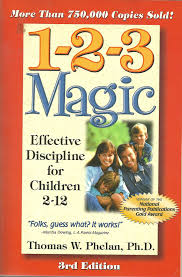Does 1-2-3 Magic Work? A Review of 1-2-3 Magic by Thomas Phelan

1-2-3 Magic, by Thomas Phelan, describes an approach to child discipline that has the advantage of being very simple to learn and follow. When a child misbehaves he or she gets two warnings before being sent to his/her room for a time out. The “1-2-3” refers to how the warnings are given. When the parent notices that his or her child is engaging in a disapproved of activity, the parent gives two warnings followed by a time out. The first warning is indicated by the parent saying “that’s one.” If the behavior continues, after five seconds, the second warning is given, “that’s two.” Finally, if the behavior continues for 5 more seconds, the parent says, “that’s three” and sends the child to his or her room for a time out. The length of the time out is equal to one minute per year of the child’s age – so 3 year olds get 3 minutes and 9 year olds get 9 minutes, etc…
Once the time out has been completed the child gets a clean slate. There is no further discussion of the misbehavior. Phelan calls this the “no talking” rule. According to Phelan, after the time out there should be “Nothing! No talking, no emotion, no apologies, no lectures, no discussions. Nothing is said.” Phelan stresses that his method is to be administered with “no emotion” – like a referee enforcing the rules in a football game. If a parent doesn’t react emotionally to misbehavior, there is no possibility of a power struggle. Power struggles feed on emotion.
One question that is often raised by parents when contemplating a 1-2-3 approach is: “what do I do if he won’t go to his room for a time out when I get to 3?” Phelan suggests using an alternative consequence to a time out that has, in his words, “a little more clout.” Examples of these “time-out alternatives” might be, depending on the age of the child, no dessert, no TV, no play date, grounding, loss of use of a phone, etc…
Like any approach to discipline, 1-2-3 Magic can only “work” if parents stick with it. It also only “works” if the method enables parents to remain calm and respectful when dealing with misbehavior. The strength of the 1-2-3 approach is in its simplicity. Faced with misbehavior, a parent knows just what to do. Knowing what to do makes it much less likely that a parent will act out of anger and frustration with yelling, scolding or criticism. 1-2-3 gives the parent an always ready emergency procedure to implement. Knowing what to do also makes it less likely that the parent will act inconsistently with discipline. Because misbehavior triggers 1-2-3, the parent is also less likely to ignore an infraction in one instance, or overreact in another. Another strength of the 1-2-3 method is its no talking rule. Many kids, boys especially, find talking about or processing conflicts to be a highly aversive thing. Often there is more ill will evoked and more misbehavior generated by trying to talk through a bad interaction with a child.
A word of caution. It is important to note that no approach to discipline is effective with every child and that limit setting approaches to discipline, like 1-2-3 Magic, come with risks. Limit setting can start off an escalating coercive power struggle that can get very heated. The child may refuse to comply with the limit, so the parents employ a more severe alternative punishment, which in turn may lead the child to greater misbehavior. If this occurs in your attempt to set limits, suspend your efforts and seek professional help.
